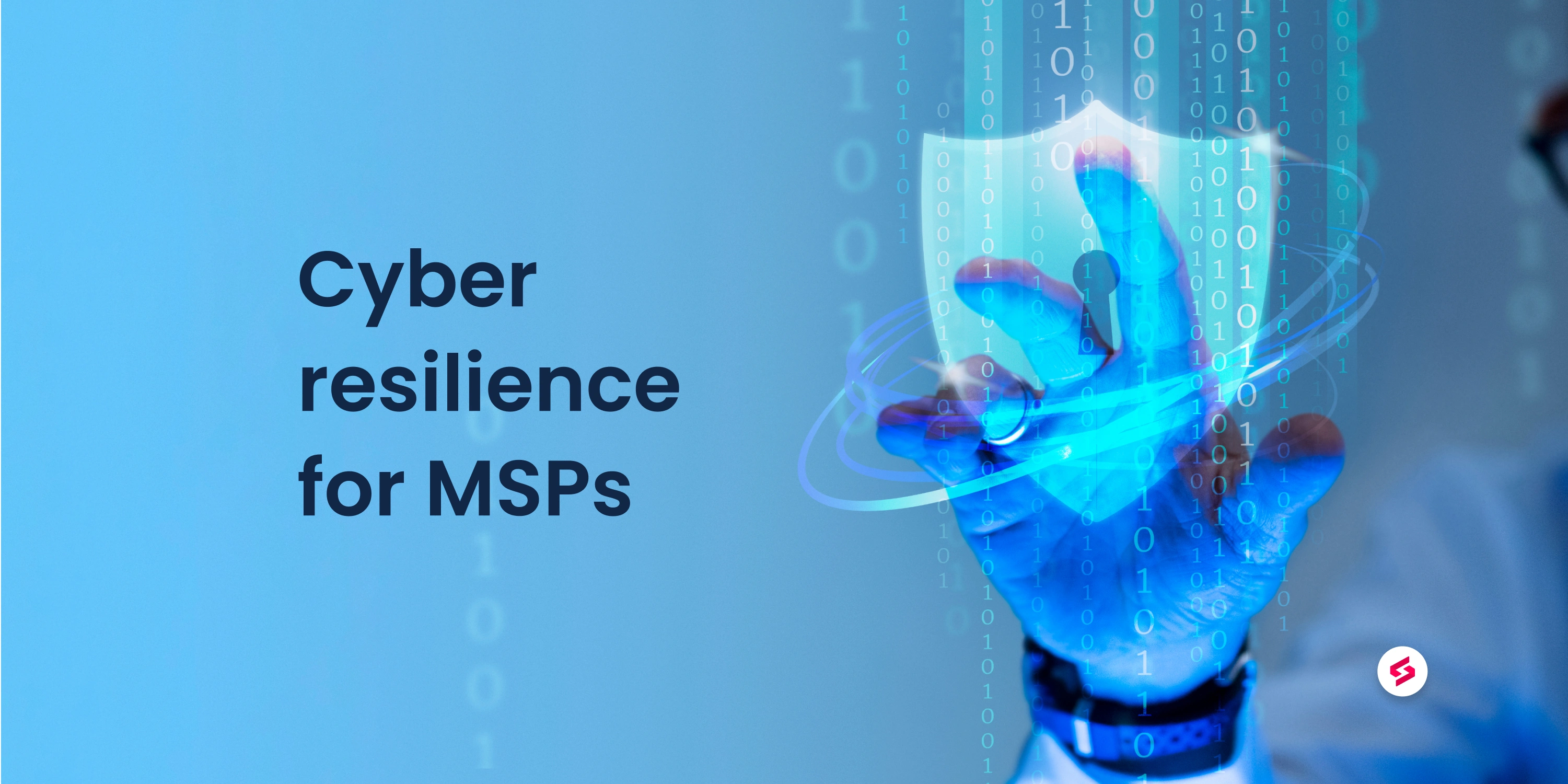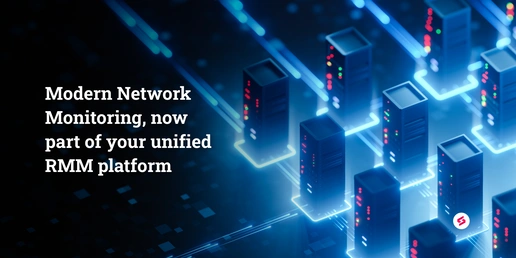Cyber-attacks have grown in risk and complexity over the years, made apparent by the increasing number of large-scale data breaches and compromises in the news each day.
What does it mean to be cyber-resilient in today’s world? A cyber-resilient business, in its most generic sense, can hold steady and deliver on its expected outcomes, regardless of interruptions and challenges in the form of data breaches, cyber threats/attacks, economic predicaments, or natural calamities. A dedicated cyber-resilience strategy streamlines business processes, enables proficiency in security, and reduces operational downtime.
As operations become digitized and the threat of cyber-attacks increases, it is imperative for businesses of all sizes to work toward building cyber-resilience. The term may sound ambiguous but it’s a core aspect of a cybersecurity strategy—it brings forth an opportunity for managed service providers to improve their level of service and credibility.
In this article, we'll deep-dive into the imminent need for cyber-resilience across industries. We'll also explore why MSPs should have a water-tight strategy to build resilience towards cyber threats and data breaches.
What is cyber-resilience?
Cyber-resilience is a business strategy or plan to deal with unexpected crises and ensure uninterrupted continuity and security of information systems, and makes organizations resilient altogether.
Simply put, it refers to an organization's ability to proactively respond to cyber threats and data breaches with predefined security strategies and cybersecurity risk management plans.
If an organization can effectively face and recover from cyber attacks without affecting the continuity of business operations, it is said to be cyber resilient.
Cyber-resilience has emerged as a predominant cyber threat management framework in the past few years because conventional security measures aren't adequately effective in reducing the cyber risk or guaranteeing continuity of business in the likely event of a cyber attack.
The underlying goal of achieving cyber-resilience is to ensure that companies are capable of deploying services and products despite cyber crises. It allows businesses to adjust and evolve mechanisms on a need-to-need basis — which is not possible with traditional security strategies.
Why do MSPs need cyber-resilience?
Cyberattacks are inevitable, it's a question of "when" they will occur, not "if" they do occur. Given the unpredictable nature and potential severity of different attacks, businesses should be equipped with incident management and attack surface management strategies to prevent attacks as well as mitigate the damage if the attack has already happened.
In contrast to cybersecurity which emphasizes the prevention of attacks with the help of firewall and security control systems, cyber-resilience is a holistic concept that focuses on operational continuity before, during, and after a cyber-attack.
Without an end-to-end solution as such, the security and recovery of an information technology infrastructure are bound to fail. For instance, a great deal of SMBs either completely disregard cybersecurity or are dependent on traditional cyber security solutions to prevent attacks.
In fact, based on surveys, no more than 26% of SMBs are protected by sufficient security measures to prevent their users and networks from cyber risks.
With the COVID-19 pandemic giving rise to remote working norms, securing a digital-first workforce presents an even greater challenge — both for MSPs and small businesses. Since employees are connected to their personal devices on their home networks, there is a greater threat of cyber-attacks and data breaches.
At times like this, MSPs have a unique opportunity to nudge business leaders in the right direction by encouraging them to become cyber-resilient. It will not only protect employees and organizations from accelerating cyber threats but also boost confidence in business.
Recent reports suggest that less than 60% of employees believe their organizations are cyber resilient while 18% of employees worldwide strongly believe they aren't. Nearly 23% have no clue whether their companies are resilient against cyber threats.
The road to resilience is expected to start with business leaders and eventually be shared by the organization's employees. Unfortunately, only 14% of employees believe it's their responsibility to steer a company towards cyber-resilience.
It is apparent from the above statistics that cyber-resilience is the need of the hour for SMBs who are still struggling with protecting their users, systems, and networks from cyber-attacks.
How does cyber-resilience work?
Cyber-resilience includes a set of dynamic and ongoing processes that are implemented based on the Information Technology Infrastructure Library (ITIL) service lifecycle. This extends from devising a strategy and designing a prototype to implementing these processes and continuously improving them.
Cyber-resilience strategy
Depending upon an organization's short and long-term goals, MSPs need to identify imminent vulnerabilities as the key assets of a business face—IT infrastructure, networks, systems, and so on.
Elements of a successful cyber-resilience strategy
There are four elements that come together to create a successful cyber-resilience strategy:
Management and protection: This means equipping oneself to identify cyber risks, assess their impact, and manage them appropriately so as to protect network and information systems. Management and protection also extend to third-party vendors and beyond.
Identification and detection: MSPs leverage continuous IT systems monitoring and implement attack surface management to identify rampant anomalies or possible data leaks before an attack occurs.
Response and recovery: This involves proactively responding to cyber incidents before, during, and after a cyberattack to facilitate business continuity.
Governance and assurance: This involves identifying areas of improvement wherein your cyber-resilience framework is continuously monitored.
Cyber-resilience design
Cyber-resilience design involves choosing the fitting controls and processes for IT infrastructure so as to best protect an organization's critical assets (users, systems, devices, network) from cyber damage. Here, it is also ascertained who (or which teams) will have the authority and jurisdiction to control the design procedures.
Cyber-resilience transition
Cyber-resilience transition includes testing controls for efficacy and operational use — based on which anomalies and incidents are detected in the design work and refined appropriately. This gives an idea about the critical assets most vulnerable to internal and external risks, be it intentional or accidental.
Cyber-resilience operation
Cyber-resilience operation work involves monitoring and detecting potential cyber incidents through continuous control testing, which helps determine the efficiency and usability of set strategies.
Cyber-resilience evolution
As the phrase suggests, cyber-resilience evolution means continually and consistently evolving existing strategies, design controls, and operational work in response to an ever-changing environment. As organizations face, respond to, and recover from cyber crises, they must leverage those experiences to further improve and streamline their cyber-resilience strategy.
How can MSPs help SMBs achieve cyber-resilience?
Cyber-resilience presents MSPs with a major opportunity to take their services to the next level by helping their clients prepare and respond to a cyberattack. More often than not, SMBs realize that they need to become cyber resilient but lack the necessary expertise or resources to devise and implement a cyber-resilience strategy.
MSPs play a major role here. They create awareness of the cyber risks clients face and direct their focus towards security-driven core business processes. The responsibility of planning a defense strategy against cyber attacks and data breaches falls directly on the MSP’s shoulders.
For MSPs, helping SMBs achieve cyber-resilience begins with educating their workforce about cyberattacks and how they can thwart them on a day-to-day basis. Beyond that, it is a matter of devising cyber-resilience strategies that cater to the business and leveraging new-age technologies and processes to implement them.
Here's breaking down the 3-step plan for MSPs when approaching clients.
Educating employees
The people of a business i.e. the employees need to be educated about potential cyber threats and risks so they can proactively respond to ransomware and cybersecurity risks. In an attempt to improve an SMB’s cybersecurity stance, MSPs should sit down with clients and equip them with the know-how of risk management.
This information can be passed down to its employees with the help of experts in the field—be it an MSP like yourself or an outside hire. Employees who are aware of cyber risks and best practices to prevent them are key for an organization to become cyber-resilient.
Streamlining processes
MSPs should help their clientele understand the need for streamlining business processes to effectively identify and mitigate risk. It typically measures recognizing areas of improvement and providing recommendations as to how SMBs can prevent attacks and other advanced online threats with the help of people and technologies.
Leveraging technology
Once you establish the importance of cyber-resilience with your clientele, show them how they can build that resilience with the help of technology at their disposal. This typically includes firewalls, VPN (Virtual Private Networks), automated security patches and updates, and anti-malware systems.
- Firewall: A firewall blocks current and future variants of a threat, and is considered your first line of defense.
- VPN: To ensure confidentiality and security of company data, it is imperative for your employees' workstations to be connected to a virtual private network. This is especially crucial in the current atmosphere where employees work from home.
- Anti-malware: An integral element in building cyber-resilience, anti-malware protects IT systems from malicious ransomware, major online threats, and more.
- Patching and firmware: IT infrastructure should have automated patching to secure your data from vulnerabilities.
Benefits of cyber-resilience
Incidentally, developing cyber-resilience allows businesses to face and thwart cyber crimes, which are advantageous to the company on the whole.
Cyber-resilience is an arduous process but comes with tremendous benefits.
A cyber-resilient business is privy to the following benefits:
- A cyber-resilient stance aids in the improvement of internal processes and culture.
- It helps build a brand reputation as a reliable player in the industry.
- Cyber-resilience streamlines operations and helps cut down on financial losses.
- It allows organizations to diligently adhere to legal and regulatory norms due to improved incident response management. Complying with NIS (Network and Information Systems) Regulations and GDPR (General Data Protection Regulation) ensures uninterrupted business continuity.
Building and maintaining a solid cyber-resilient posture isn’t easy. Each employee in the organization needs a meticulous and persistent mindset to carry it forward, holding security in the highest regard. But when done right, your clients will love you for it, bringing more opportunities than ever before.




